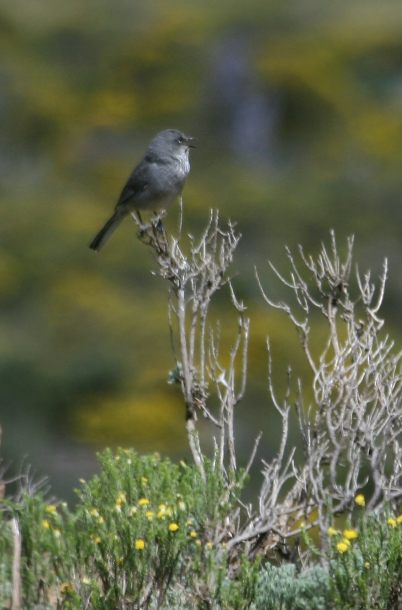Alternative name: Layard's Tit-babbler
- Parisoma layardi
Sylvia layardi
Identification
Length 14-16 cm, mass 15 g. Adult male: The upper parts are grey and the tail black with a white tip and white edges. The white throat has black streaks, the lower breast and belly are pale grey, and the flanks darker grey. The vent is white. The eyes are white and the bill and legs are black. Adult female: Browner than the male and less markedly streaked on the throat, but it is difficult to distinguish the sexes in the field.
The Rufous-vented Warbler is similar but has a chestnut vent.
Distribution
Western Namibia, western and central South Africa and Lesotho.
Taxonomy
This species was moved from the genus Sylvia to the genus Parisoma, but has recently been moved back to Sylvia.
P. layardi has four subspecies: The nominate race from the South African west coast (described under 'Identification'); P. l. barnsi from Lesotho and adjascent parts of South Africa, darker than the nominate race above and paler below; P. l. aridicola from Namibia and adjascent parts of South Africa, upper parts paler than P. l. barnesi and there is no white on the wings and face; P. l. subsolanum from central South Africa, upper parts darker than P. l. aridicola and paler than P. l. barnesi. Compared to the nominate race, P. l. subsolanum is darker below, and the breast is more buffy.
Habitat
Shrublands and fynbos.
Behaviour
Generally resident, with seasonal altitudinal movement by populations in cooler areas. Usually forages alone or in pairs for invertebrates and fruits, low in shrubs. Inquisitive; responds to spishing.
Breeding: Monogamous and teritorial. The nest is a cup constructed from grass, plant fibres and spiders web. Usually 2 eggs are laid between July and December.
References
Hockey PAR, Dean WRJ & Ryan PG (eds) 2005. Robert's Birds of Southern Africa, 7th edition. John Voelcker Bird Book Fund, Cape Town, South Africa. ISBN 0620340533




